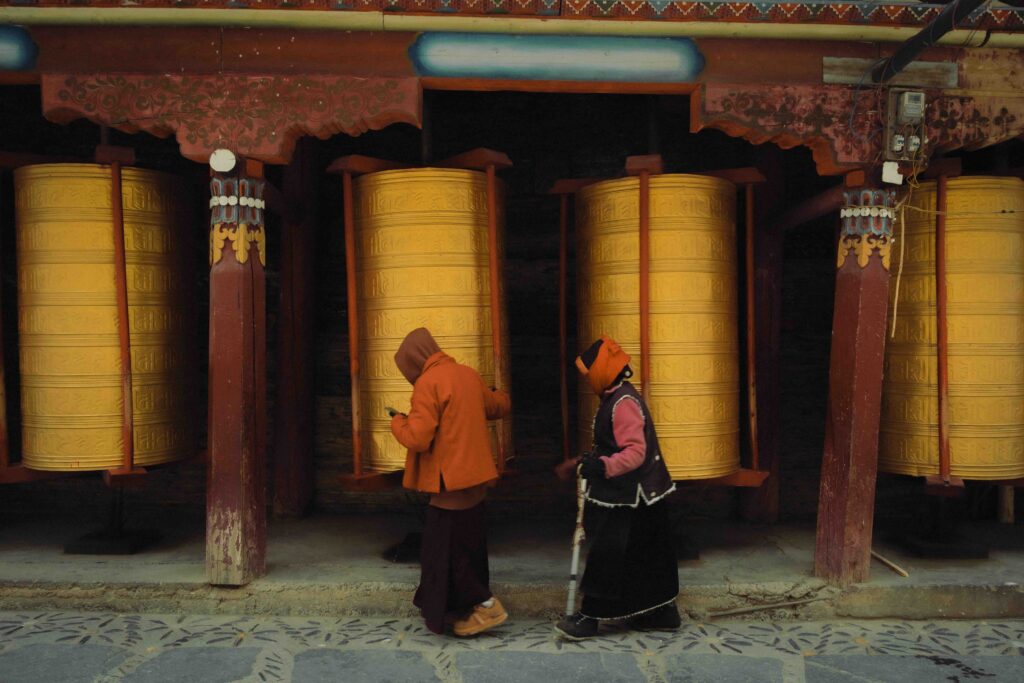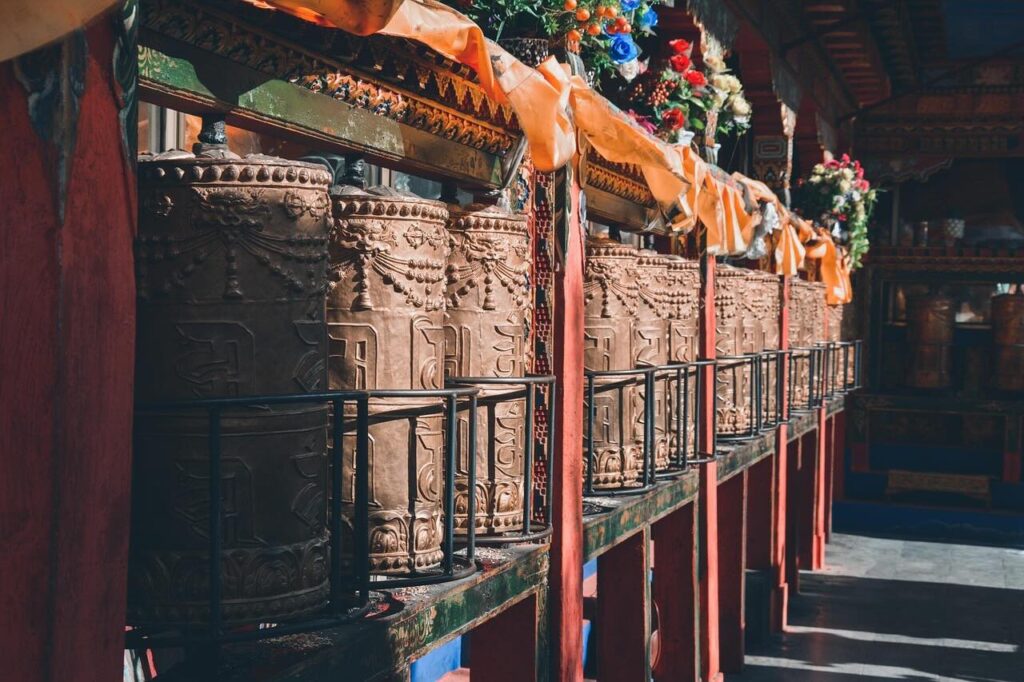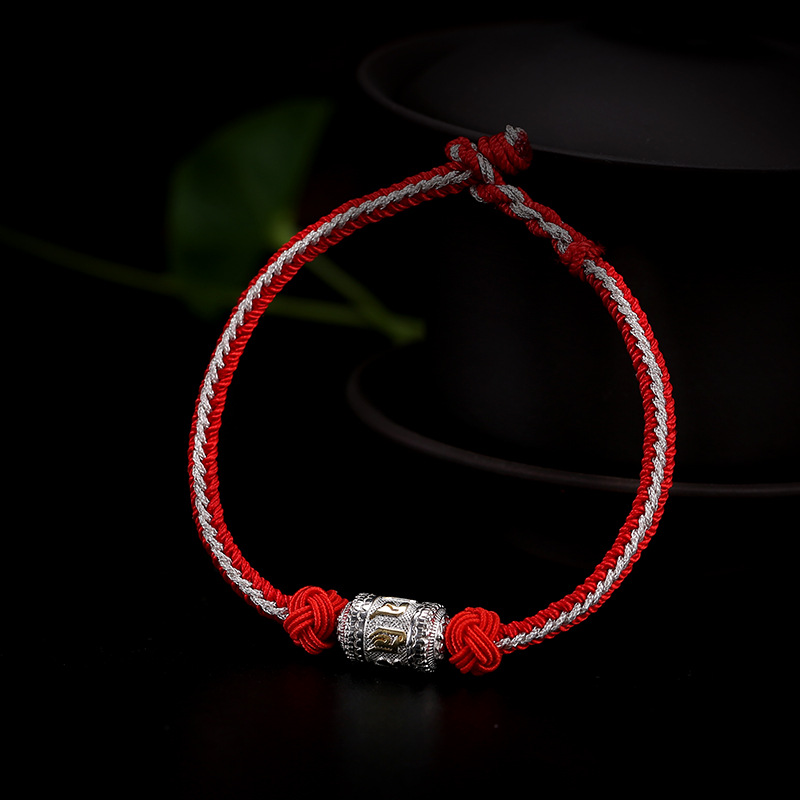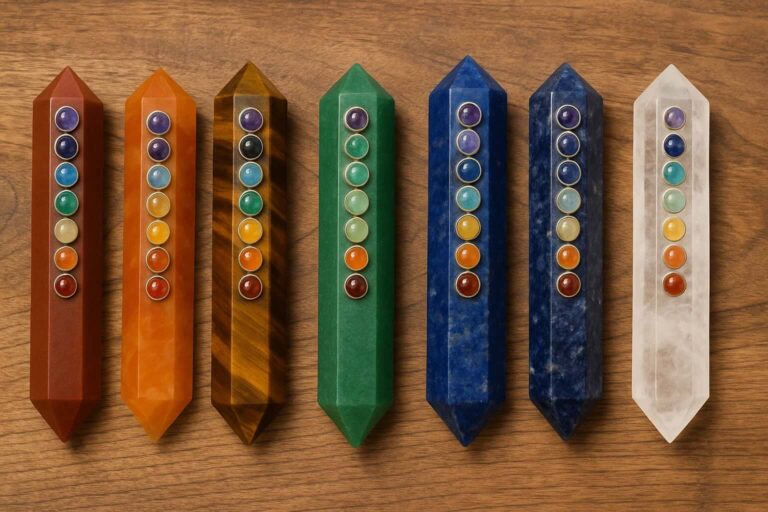The Complete Guide to Tibetan Buddhist Prayer Wheels: Sacred Spinning Devices for Spiritual Practice
In this article
- 1 Introduction
- 2 What is a Tibetan Buddhist Prayer Wheel?
- 3 The Rich History and Origins of Prayer Wheels
- 4 Types of Tibetan Buddhist Prayer Wheels
- 5 The Spiritual Significance and Benefits
- 6 How to Use a Tibetan Buddhist Prayer Wheel Properly
- 7 Construction and Sacred Elements
- 8 Choosing an Authentic Tibetan Buddhist Prayer Wheel
- 9 Prayer Wheels in Modern Buddhist Practice
- 10 Caring for Your Prayer Wheel
- 11 The Science Behind the Spiritual Practice
- 12 Prayer Wheels and Tibetan Cultural Preservation
- 13 Conclusion
Introduction
The Tibetan Buddhist prayer wheel stands as one of the most recognizable and spiritually significant objects in Buddhist culture. These sacred spinning cylinders, known as “mani wheels” or “prayer wheels,” have been an integral part of Tibetan Buddhist practice for over a millennium. Whether you’re a spiritual seeker, cultural enthusiast, or simply curious about this ancient tradition, understanding the prayer wheel’s significance can deepen your appreciation for Tibetan Buddhist culture.
What is a Tibetan Buddhist Prayer Wheel?
A Tibetan Buddhist prayer wheel is a cylindrical device containing written prayers, mantras, or sacred texts that practitioners spin while reciting mantras. The most common mantra associated with prayer wheels is “Om Mani Padme Hum,” the six-syllable mantra of Avalokiteshvara, the bodhisattva of compassion.
These sacred instruments come in various sizes, from small handheld versions to massive wheels that require multiple people to turn. Each rotation is believed to generate the same spiritual merit as verbally reciting the prayers contained within the wheel.
The Rich History and Origins of Prayer Wheels
Ancient Beginnings
The tradition of Tibetan Buddhist prayer wheels dates back to the 4th century CE, though they became particularly prominent in Tibet during the 8th century. Historical records suggest that the practice may have evolved from the Indian Buddhist tradition of circumambulating stupas and sacred objects.
Development in Tibet
As Buddhism spread throughout Tibet, prayer wheels became deeply integrated into daily spiritual practice. Tibetan monks and laypeople alike adopted these devices as a means of accumulating merit and maintaining continuous spiritual practice throughout their daily activities.
Types of Tibetan Buddhist Prayer Wheels
Handheld Prayer Wheels
The most common type, handheld prayer wheels are portable devices that practitioners can carry and spin during walks, meditation, or daily activities. These typically range from 6 to 12 inches in height and feature ornate decorations.
Temple Prayer Wheels
Large stationary prayer wheels found in monasteries and temples can reach several feet in height. These communal wheels allow multiple practitioners to participate in the spinning ritual simultaneously.
Water Prayer Wheels
Ingeniously designed to harness natural water flow, these wheels spin continuously in streams and rivers, generating constant spiritual merit without human intervention.
Wind Prayer Wheels
Similar to water wheels, wind-powered prayer wheels utilize natural air currents to maintain perpetual motion, symbolizing the continuous nature of compassion and spiritual practice.
 The Spiritual Significance and Benefits
The Spiritual Significance and Benefits
Accumulating Merit
According to Tibetan Buddhist belief, each rotation of a prayer wheel generates the same spiritual merit as reciting the enclosed mantras once. This makes prayer wheels an efficient method for accumulating positive karma.
Mindfulness Practice
The rhythmic spinning motion helps practitioners maintain focus and mindfulness, creating a meditative state that supports spiritual development.
Compassion Cultivation
Since most prayer wheels contain the Avalokiteshvara mantra, regular use is believed to cultivate compassion and loving-kindness toward all sentient beings.
Purification of Negative Karma
Traditional teachings suggest that spinning prayer wheels helps purify negative karma and obstacles to spiritual progress.
How to Use a Tibetan Buddhist Prayer Wheel Properly
Basic Technique
- Hold the prayer wheel in your right hand
- Spin it clockwise (when viewed from above)
- Recite “Om Mani Padme Hum” or other appropriate mantras
- Maintain mindful awareness throughout the practice
Proper Mindset
Approach the practice with reverence, compassion, and the intention to benefit all sentient beings. The effectiveness of the practice depends largely on the practitioner’s motivation and mindfulness.
Duration and Frequency
There are no strict rules regarding duration. Some practitioners spin prayer wheels for a few minutes daily, while others incorporate them into longer meditation sessions or pilgrimages.
Construction and Sacred Elements
Materials Used
Traditional Tibetan Buddhist prayer wheels are crafted from various materials including:
- Copper and brass for the cylinder
- Wood for handles and decorative elements
- Precious metals for ornate versions
- Paper or cloth for containing the mantras
Sacred Inscriptions
The exterior often features:
- Mantras in Tibetan script
- Sacred symbols like the eight auspicious symbols
- Images of buddhas and bodhisattvas
- Protective deities and spiritual motifs
Interior Contents
Inside each wheel, you’ll typically find:
- Rolled paper or cloth with printed mantras
- Thousands of repetitions of “Om Mani Padme Hum“
- Sometimes additional prayers and sacred texts
- Blessed substances like relics or consecrated materials
 Choosing an Authentic Tibetan Buddhist Prayer Wheel
Choosing an Authentic Tibetan Buddhist Prayer Wheel
Quality Indicators
When selecting a prayer wheel, consider:
- Authentic Tibetan craftsmanship
- Proper construction with sealed interior
- Quality materials that will withstand regular use
- Appropriate size for your intended practice
Ethical Considerations
Support authentic Tibetan artisans and businesses when possible. Many prayer wheels sold today help support Tibetan communities in exile and preserve traditional craftsmanship.
Blessing and Consecration
Traditional prayer wheels benefit from blessing by qualified Buddhist teachers. Many practitioners seek to have their wheels consecrated by lamas or experienced monks.
Prayer Wheels in Modern Buddhist Practice
Integration with Daily Life
Contemporary practitioners often incorporate prayer wheels into:
- Morning and evening meditation routines
- Walking meditation practices
- Commuting and travel
- Stressful situations requiring centering
Prayer Wheel-Inspired Jewelry and Accessories
Many devoted practitioners choose to wear prayer wheel-inspired jewelry as a way to carry their spiritual practice throughout the day. These miniature prayer wheel bracelets, pendants, and rings serve multiple purposes beyond mere decoration. They act as constant reminders of one’s spiritual commitment, helping practitioners maintain mindfulness during busy daily activities. Additionally, wearing these sacred symbols allows individuals to share their Buddhist faith with others, often sparking meaningful conversations about the prayer wheel’s significance and the principles of compassion central to Buddhist practice. While these jewelry pieces may not contain actual mantras like traditional prayer wheels, they embody the same spiritual intention and serve as portable talismans of devotion.
 Global Adoption
Global Adoption
While rooted in Tibetan tradition, prayer wheels have gained popularity among Buddhist practitioners worldwide, adapting to various cultural contexts while maintaining their essential spiritual function.
Caring for Your Prayer Wheel
Maintenance Tips
- Handle with clean hands and respectful attitude
- Store in a clean, elevated place when not in use
- Avoid dropping or damaging the sacred contents
- Regular gentle cleaning of the exterior surfaces
Long-term Preservation
- Protect from moisture and extreme temperatures
- Check for loose components periodically
- Consider professional restoration for antique wheels
- Pass down to future generations with proper instruction
The Science Behind the Spiritual Practice
Psychological Benefits
Research suggests that repetitive, mindful activities like spinning prayer wheels can:
- Reduce stress and anxiety
- Improve focus and concentration
- Promote emotional regulation
- Enhance overall well-being
Meditative States
The rhythmic motion combined with mantra recitation can induce meditative states similar to other contemplative practices, supporting mental clarity and inner peace.
Prayer Wheels and Tibetan Cultural Preservation
Cultural Significance
Prayer wheels represent more than religious objects; they embody Tibetan cultural identity and spiritual heritage. Supporting their traditional manufacture and use helps preserve this endangered culture.
Educational Value
These sacred devices serve as tangible connections to Tibetan Buddhism’s rich philosophical and practical traditions, offering insights into compassion-based spirituality.
Conclusion
The Tibetan Buddhist prayer wheel stands as a remarkable fusion of practical spirituality and sacred technology. Whether you’re drawn to its meditative benefits, cultural significance, or spiritual symbolism, the prayer wheel offers a tangible way to engage with the profound wisdom of Tibetan Buddhism.
By understanding the proper use, significance, and care of these sacred instruments, practitioners can fully appreciate their role in the path toward wisdom and compassion. As you consider incorporating a prayer wheel into your spiritual practice, remember that its true power lies not in the mechanical spinning, but in the sincere motivation and mindful awareness you bring to the practice.
The ancient wisdom contained within each prayer wheel continues to offer guidance and blessing to practitioners worldwide, perpetuating the timeless Buddhist aspiration for the liberation and happiness of all sentient beings.
For authentic Tibetan Buddhist prayer wheels and guidance on traditional practices, consult with qualified Buddhist teachers and reputable suppliers who support Tibetan communities and preserve traditional craftsmanship methods.
Related Reading:
Om Mani Padme Hum Significato: 7 Ultimate Meanings & Spiritual Powers


 The Spiritual Significance and Benefits
The Spiritual Significance and Benefits Choosing an Authentic Tibetan Buddhist Prayer Wheel
Choosing an Authentic Tibetan Buddhist Prayer Wheel





